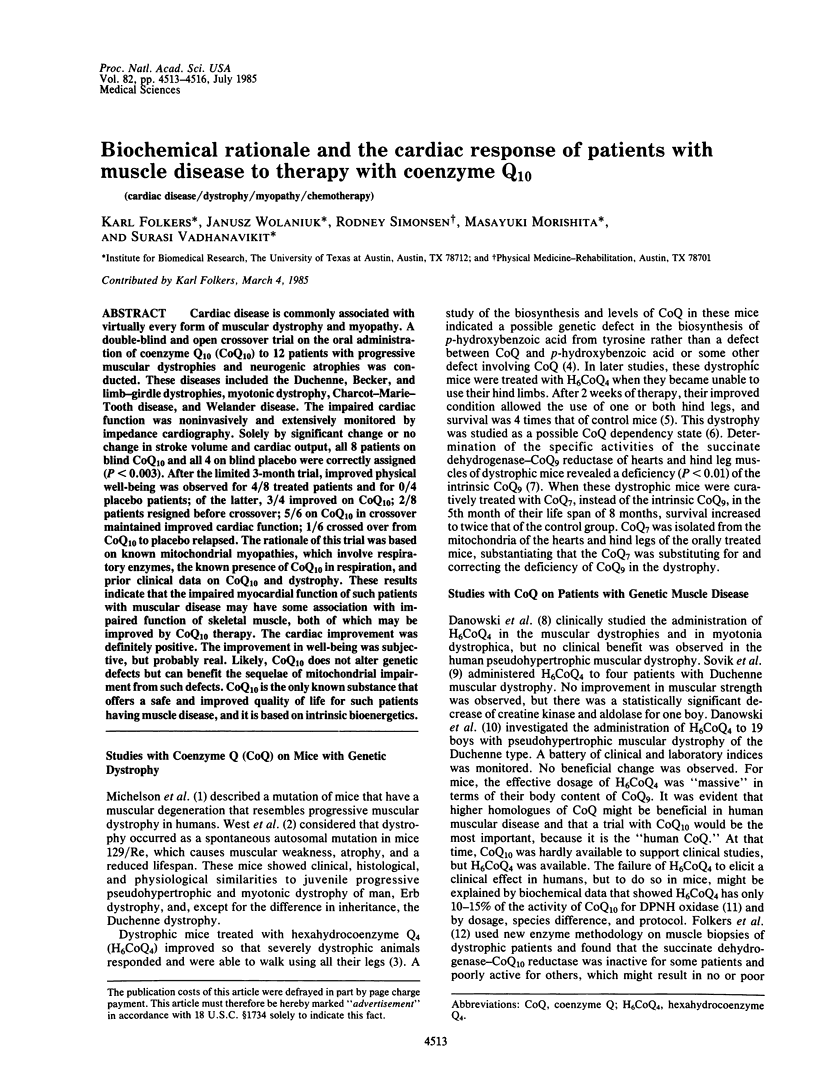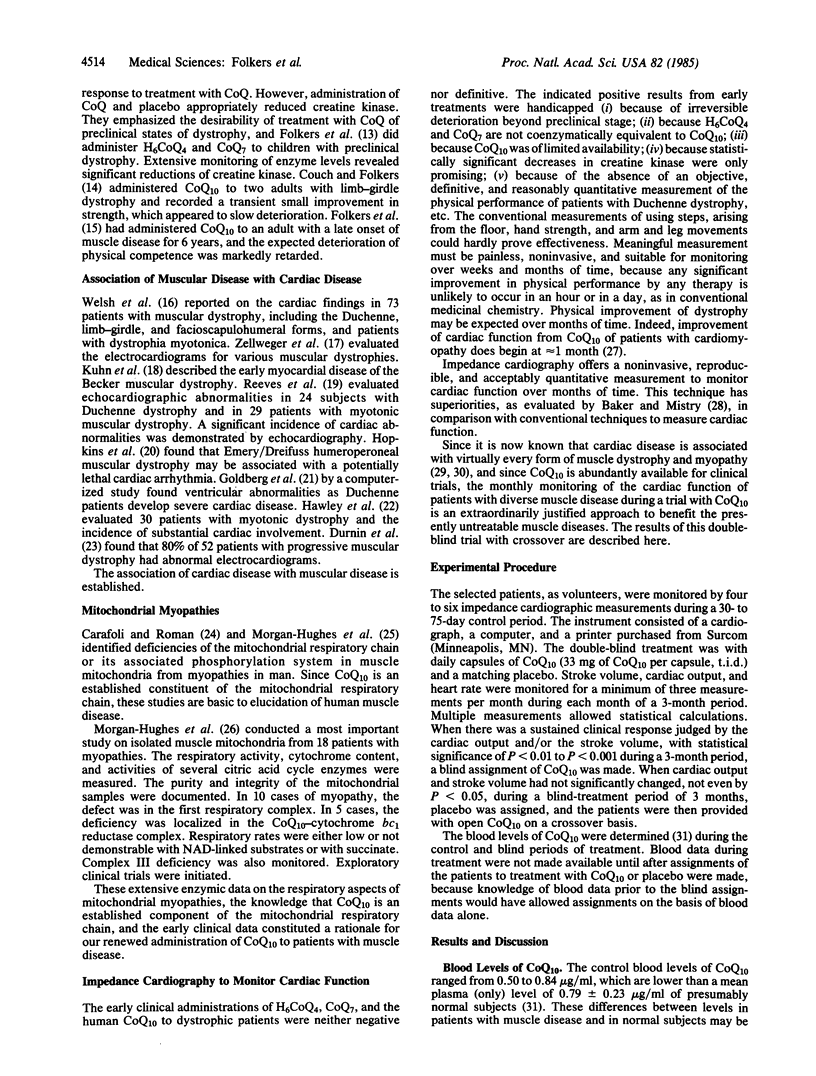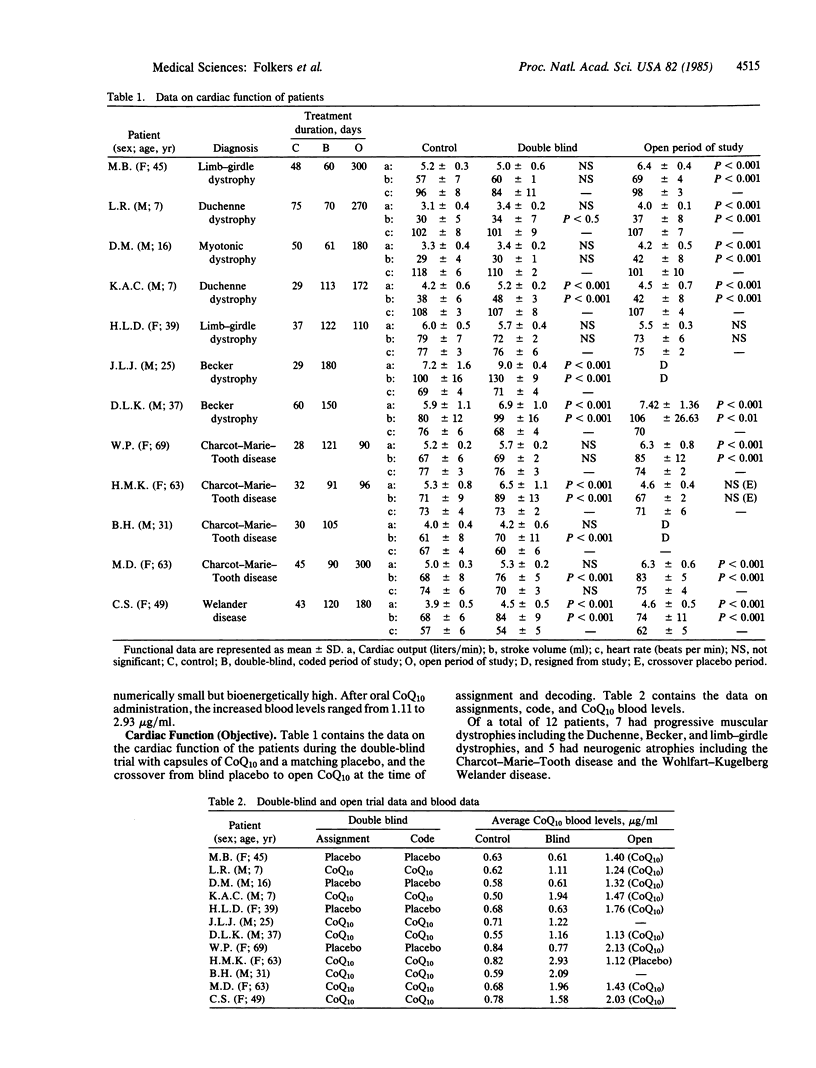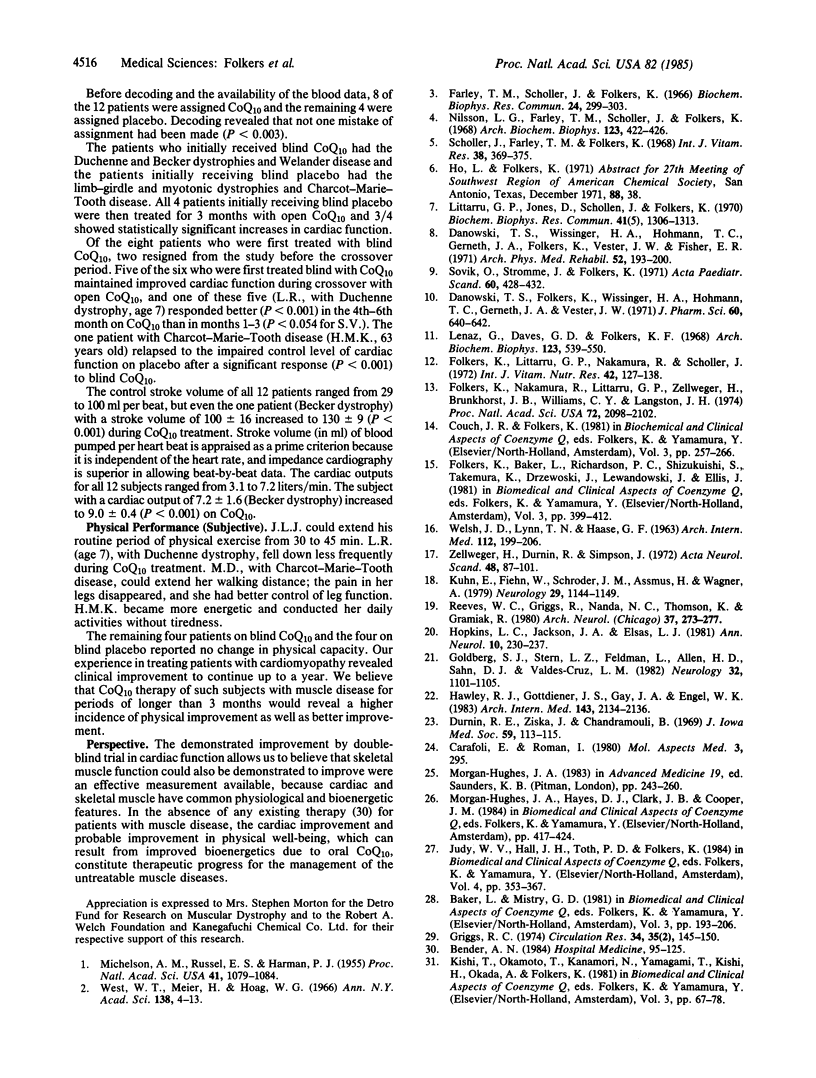Abstract
Cardiac disease is commonly associated with virtually every form of muscular dystrophy and myopathy. A double-blind and open crossover trial on the oral administration of coenzyme Q10 (CoQ10) to 12 patients with progressive muscular dystrophies and neurogenic atrophies was conducted. These diseases included the Duchenne, Becker, and limb-girdle dystrophies, myotonic dystrophy, Charcot-Marie-Tooth disease, and Welander disease. The impaired cardiac function was noninvasively and extensively monitored by impedance cardiography. Solely by significant change or no change in stroke volume and cardiac output, all 8 patients on blind CoQ10 and all 4 on blind placebo were correctly assigned (P less than 0.003). After the limited 3-month trial, improved physical well-being was observed for 4/8 treated patients and for 0/4 placebo patients; of the latter, 3/4 improved on CoQ10; 2/8 patients resigned before crossover; 5/6 on CoQ10 in crossover maintained improved cardiac function; 1/6 crossed over from CoQ10 to placebo relapsed. The rationale of this trial was based on known mitochondrial myopathies, which involve respiratory enzymes, the known presence of CoQ10 in respiration, and prior clinical data on CoQ10 and dystrophy. These results indicate that the impaired myocardial function of such patients with muscular disease may have some association with impaired function of skeletal muscle, both of which may be improved by CoQ10 therapy. The cardiac improvement was definitely positive. The improvement in well-being was subjective, but probably real. Likely, CoQ10 does not alter genetic defects but can benefit the sequelae of mitochondrial impairment from such defects. CoQ10 is the only known substance that offers a safe and improved quality of life for such patients having muscle disease, and it is based on intrinsic bioenergetics.
Full text
PDF



Selected References
These references are in PubMed. This may not be the complete list of references from this article.
- Danowski T. S., Folkers K., Wissinger H. A., Hohmann T. C., Gerneth J. A., Vester J. W. Hexahydrocoenzyme Q 4 in pseudohypertrophic muscular dystrophy. J Pharm Sci. 1971 Apr;60(4):640–642. doi: 10.1002/jps.2600600437. [DOI] [PubMed] [Google Scholar]
- Danowski T. S., Wissinger H. A., Hohmann T. C., Gerneth J. A., Folkers K., Vester J. W., Fisher E. R. Tabulation of findings in the muscular dystrophies and in myotonia dystrophica. Arch Phys Med Rehabil. 1971 May;52(5):193–200. [PubMed] [Google Scholar]
- Durnin R. E., Chandramouli B. The electrocardiogram in pseudohypertrophic or Duchenne's muscular dystrophy (type 3a). J Iowa Med Soc. 1969 Feb;59(2):113–115. [PubMed] [Google Scholar]
- Farley T. M., Scholler J., Folkers K. Response of genetically dystrophic mice to therapy with hexahydrocoenzyme Q4. Biochem Biophys Res Commun. 1966 Aug 12;24(3):299–303. doi: 10.1016/0006-291x(66)90154-9. [DOI] [PubMed] [Google Scholar]
- Folkers K., Nakamura R., Littarru G. P., Zellweger H., Brunkhorst J. B., Williams C. W., Jr, Langston J. H. Effect of coenzyme Q on serum levels of creatine phosphokinase in preclinical muscular dystrophy. Proc Natl Acad Sci U S A. 1974 May;71(5):2098–2102. doi: 10.1073/pnas.71.5.2098. [DOI] [PMC free article] [PubMed] [Google Scholar]
- Goldberg S. J., Stern L. Z., Feldman L., Allen H. D., Sahn D. J., Valdes-Cruz L. M. Serial two-dimensional echocardiography in Duchenne muscular dystrophy. Neurology. 1982 Oct;32(10):1101–1105. doi: 10.1212/wnl.32.10.1101. [DOI] [PubMed] [Google Scholar]
- Hawley R. J., Gottdiener J. S., Gay J. A., Engel W. K. Families with myotonic dystrophy with and without cardiac involvement. Arch Intern Med. 1983 Nov;143(11):2134–2136. [PubMed] [Google Scholar]
- Hopkins L. C., Jackson J. A., Elsas L. J. Emery-dreifuss humeroperoneal muscular dystrophy: an x-linked myopathy with unusual contractures and bradycardia. Ann Neurol. 1981 Sep;10(3):230–237. doi: 10.1002/ana.410100306. [DOI] [PubMed] [Google Scholar]
- Kuhn E., Fiehn W., Schröder J. M., Assmus H., Wagner A. Early myocardial disease and cramping myalgia in Becker-type muscular dystrophy: a kindred. Neurology. 1979 Aug;29(8):1144–1149. doi: 10.1212/wnl.29.8.1144. [DOI] [PubMed] [Google Scholar]
- Lenaz G., Daves G. D., Jr, Kfolkers K. Organic structural specificity and sites of coenzyme Q in succinoxidase and DPNH-oxidase systems. Arch Biochem Biophys. 1968 Mar 11;123(3):539–550. doi: 10.1016/0003-9861(68)90175-6. [DOI] [PubMed] [Google Scholar]
- Littarru G. P., Jones D., Scholler J., Folkers K. Deficiency of coenzyme Q 10 in a succinate-CoQ 10 -Enzyme in the dystrophic rabbit on an antioxidant deficient diet. Int J Vitam Nutr Res. 1972;42(1):127–138. [PubMed] [Google Scholar]
- Littarru G. P., Jones D., Scholler J., Folkers K. Deficiency of coenzyme Q9 in mice having hereditary muscular dystrophy. Biochem Biophys Res Commun. 1970 Dec 9;41(5):1306–1313. doi: 10.1016/0006-291x(70)90231-7. [DOI] [PubMed] [Google Scholar]
- Michelson A. M., Russell E. S., Harman P. J. Dystrophia Muscularis: A HEREDITARY PRIMARY MYOPATHY IN THE HOUSE MOUSE. Proc Natl Acad Sci U S A. 1955 Dec 15;41(12):1079–1084. doi: 10.1073/pnas.41.12.1079. [DOI] [PMC free article] [PubMed] [Google Scholar]
- Nilsson J. L., Farley T. M., Scholler J., Folkers K. Biosynthesis and levels of coenzyme Q in genetically dystrophic mice. Arch Biochem Biophys. 1968 Feb;123(2):422–426. doi: 10.1016/0003-9861(68)90157-4. [DOI] [PubMed] [Google Scholar]
- Reeves W. C., Griggs R., Nanda N. C., Thomson K., Gramiak R. Echocardiographic evaluation of cardiac abnormalities in Duchenne's dystrophy and myotonic muscular dystrophy. Arch Neurol. 1980 May;37(5):273–277. doi: 10.1001/archneur.1980.00500540051004. [DOI] [PubMed] [Google Scholar]
- Scholler J., Farley T. M., Folkers K. Response of mice with genetic dystrophy to therapy with coenzyme Q. Int Z Vitaminforsch. 1968;38(3):369–375. [PubMed] [Google Scholar]
- Sövik O., Strömme J. H., Folkers K. Coenzyme O in Duchenne muscular dystrophy. A preliminary therapeutic trial. Acta Paediatr Scand. 1971 Jul;60(4):428–432. doi: 10.1111/j.1651-2227.1971.tb06681.x. [DOI] [PubMed] [Google Scholar]
- WELSH J. D., LYNN T. N., Jr, HAASE G. R. CARDIAC FINDINGS IN 73 PATIENTS WITH MUSCULAR DYSTROPHY. Arch Intern Med. 1963 Aug;112:199–206. doi: 10.1001/archinte.1963.03860020097012. [DOI] [PubMed] [Google Scholar]
- West W. T. Hereditary mouse muscular dystrophy with particular emphasis on pathogenesis and attempts at therapy. Ann N Y Acad Sci. 1966 Sep 9;138(1):4–13. [PubMed] [Google Scholar]
- Zellweger H., Durnin R., Simpson J. The diagnostic significance of serum enzymes and electrocardiogram in various muscular dystrophies. Acta Neurol Scand. 1972;48(1):87–101. doi: 10.1111/j.1600-0404.1972.tb07529.x. [DOI] [PubMed] [Google Scholar]


